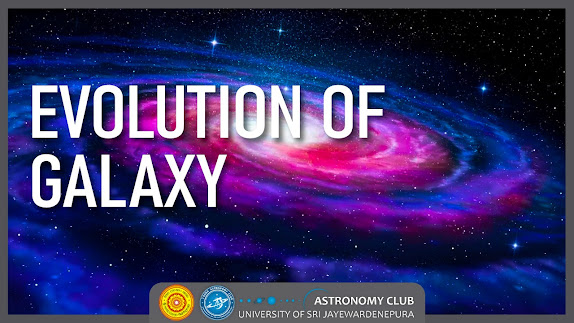EVOLUTION OF GALAXY
Galaxies are home to most of the
stars in the universe. In the early universe, there were no galaxies. Today,
there are billions. How did they form? Astronomers use the fundamental laws of
physics to deduce the basic story of galaxy formation. Galaxies form out of
immense clouds of gas that collapse and rotate. As they evolve, stars form
within them. Entire galaxies can collide, changing their appearance. Looking
deep into space, we can see galaxies at earlier stages of their lives, and
learn more about their evolution. They are more numerous, display unusual
shapes, and have episodes of energetic outbursts. Galaxies can be seen back to
more than 10 billion years ago. So Individual galaxies generally evolve in one
of three ways.
The first one is Passive Evolution in which the galaxy
remains undisturbed by mergers or interactions, and is devoid of ongoing star
formation. These galaxies become steadily fainter and redder as the brighter,
high-mass (bluer) stars exit the main sequence and evolve into red giants.
Otherwise, the galaxy remains unchanged. Isolated, early-type (elliptical and
S0) galaxies generally evolve in this way.
The second is Interactions and Mergers which may or may not produce new stars.
Interactions in which no new stars are formed result only in the evolution of
the morphology of the galaxies. For example, a spiral galaxy may evolve into a
S0 galaxy, or an S0 galaxy into an elliptical galaxy, without changing the
colours and luminosities of the individual galaxies. On the other hand,
interactions that do result in the formation of new stars change the luminosity
and colour as well as the morphology of each of the galaxies. Bursts of star
formation increase the luminosities of the galaxies which, on average, become
bluer in color due to the presence of high-mass stars in the young population.
However, as the galaxies continue to evolve, their color and luminosity will
return to pre-interaction levels as these young, high-mass stars move off the
main sequence. The third is, Secular
Evolution. In this case, spiral galaxies evolve in color, luminosity and
perhaps morphology through the action of internal processes such as the
formation of spiral arms or bars.
Also, Research into how the population of galaxies as a whole has evolved has provided some important insights into galaxy evolution. One of the most important results, the Butcher-Oemler effect, shows that on average, galaxies were bluer in the past than they are today. This indicates that the rate of star formation in the Universe has declined in recent times and that the rate of galaxy evolution is slower today than in the past. However, we can say galaxies are one of the wonderful creation of the universe.
©️ Pavithra Lakshani
Graphic by : Heshani Jananjalee
J'pura Astronomy Club
🌕🌖🌗🌘🌑🌒🌓🌔🌕
#japuraAstro




Comments
Post a Comment